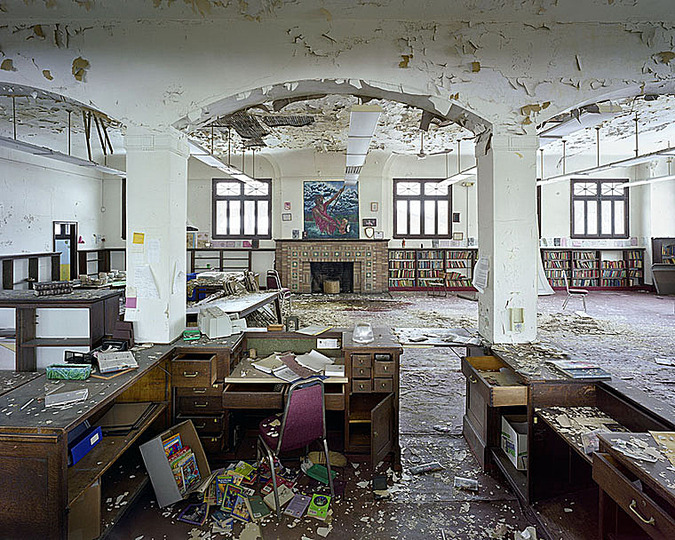Detroit etc
Text: http://www.econtalk.org/archives/2013/04/glaeser_on_citi.html
Images: Yves Marchand and Romain Meffre, http://www.marchandmeffre.com
Russ: Topic is cities; start with recent post you had at the New York Times's blog, Economix, on Detroit. Give us a brief history of that city. It's not doing well right now, but it wasn't always that way, was it? Guest: No. If you look back 120 years ago or so, Detroit looked like one of the most entrepreneurial places on the planet. It seemed as if there was an automotive genius on every street corner. If you look back 60 years ago, Detroit was among the most productive places on the planet, with the companies that were formed by those automotive geniuses coming to fruition and producing cars that were the technological wonder of the world. So, Detroit's decline is of more recent heritage, of the past 50 years. And it's an incredible story, an incredible tragedy. And it tells us a great deal about the way that cities work and the way that local economies function.
Russ: So, what went wrong? Guest: If we go back to those small-scale entrepreneurs of 120 years ago--it's not just Henry Ford; it's the Dodge brothers, the Fisher brothers, David Dunbar Buick, Billy Durant nearby Flint--all of these men were trying to figure out how to solve this technological problem, making the automobile cost effective, produce cheap, solid cars for ordinary people to run in the world. They managed to do that, Ford above all, by taking advantage of each other's ideas, each other supplies, financing that was collaboratively arranged. And together they were able to achieve this remarkable technological feat. The problem was the big idea was a vast, vertically integrated factory. And that's a great recipe for short run productivity, but a really bad recipe for long run reinvention. And a bad recipe for urban areas more generally, because once you've got a River Rouge plant, once you've got this mass vertically integrated factory, it doesn't need the city; it doesn't give to the city. It's very, very productive but you could move it outside the city, as indeed Ford did when he moved his plant from the central city of Detroit to River Rouge. And then of course once you are at this stage of the technology of an industry, you can move those plants to wherever it is that cost minimization dictates you should go. And that's of course exactly what happens. Jobs first suburbanized, then moved to lower cost areas. The work of Tom Holmes at the U. of Minnesota shows how remarkable the difference is in state policies towards unions, labor, how powerful those policies were in explaining industrial growth after 1947. And of course it globalizes. It leaves cities altogether. And that's exactly what happened in automobiles. In some sense--and what was left was relatively little, because it's a sort of inversion[?] of the natural resource curse, because it was precisely because Detroit had these incredibly productive machines that they squeezed out all other sources of invention--rather than having lots of small entrepreneurs you had middle managers for General Motors (GM) and Ford. And those guys were not going to be particularly adept at figuring out some new industry and new activity when the automobile production moved elsewhere or declined. And that's at least how I think about this--that successful cities today are marked by small firms, smart people, and connections to the outside world. And that was what Detroit was about in 1890 but it's not what Detroit was about in 1970. And I think that sowed the seeds of decline.
Russ: So, one way to describe what you are saying is in the early part of the 20th century, Detroit was something like Silicon Valley, a hub of creative talent, a lot of complementarity between the ideas and the supply chain and interactions between those people that all came together. Lots of competition, which encouraged people to try harder and innovate, or do the best they could. Are you suggesting then that Silicon Valley is prone to this kind of change at some point? If the computer were to become less important somewhere down the road or produced in a different way? Guest: The question is to what extent do the Silicon Valley firms become dominated by very strong returns to scale, a few dominant firms capitalize on it. I think it's built into the genes of every industry that they will eventually decline. The question is whether or not the region then reinvents itself. And there are two things that enable particular regions to reinvent themselves. One is skills, measured education, human capital. The year, the share or the fraction in the metropolitan area with a college degree as of 1940 or 1960 or 1970 has been a very good predictor of whether, particularly northeastern or northwestern metropolitan areas, have been able to turn themselves around. And a particular form of human capital, entrepreneurial human capital, also seems to be critical, despite the fact that our proxies for entrepreneurial talent are relatively weak. We typically use things like the number of establishments per worker in a given area, or the share of employment in startups from some initial time period. Those weak proxies are still very, very strong predictors of urban regeneration, places that have lots of little firms have managed to do much better than places that were dominated by a few large firms, particularly if they are in a single industry. So, let's think for a second about Silicon Valley. Silicon Valley has lots of skilled workers. That's good. But what I don't know is whether Silicon Valley is going to look like it's dominated by a few large firms, Google playing the role of General Motors.
Or whether or not it will continue to have lots of little startups. There's nothing wrong with big firms in terms of productivity. But they tend to train middle managers, not entrepreneurs. So that's, I think the other thing to look for. And one of the things that we have seen historically is that those little entrepreneurs are pretty good at switching industries when they need to. Think about New York, which, the dominated industry in New York was garment manufacturing. It was a large industrial cluster in the 1950s than automobile production was. But those small scale people who led those garment firms, they were pretty adept at doing something else when the industry jettisoned hundreds of thousands of jobs in the 1960s. No way that the middle managers for U.S. Steel or General Motors were not. Russ: So, I want to stick with this general issue for a minute and then we'll come back to Detroit. But I've heard this before that the way that a city thrives--it's become to me a bizarre policy cliche--you need lots of college graduates. As if somehow that's a magic wand. And, number one, it doesn't seem like a guaranteed magic wand. And number two, we don't know anything really about why college graduates like to live in particular cities. If you are Iowa City--that's a bad example. Let me pick Biloxi, Mississippi or Wichita, Kansas that don't have as many college graduates as, say, Raleigh Durham or the Silicon Valley, and you are the mayor of one of those towns, of which there are millions, and you are told: Oh, we know how to make the town do better. We just need more college graduates. So what's the policy implication of that for the mayor?
Guest: Well, it's only slightly more helpful than reminding the mayors of the power of January temperature in predicting areas' success, which is an even more useless fact that I'm prone to remind people of. You are right. There are relatively limited things, certainly in the short run, that you can do about it. I tend to think that this just pushes you back toward the basics of good city government, that college graduates are not fundamentally different in the sense that they care about good schools and decent commutes and safe streets. I do think there is a little bit of bite in it, though, when you think about local redistribution. So, I think there are lots of reasons why we should be wary of localities trying to run their own social safety nets, the ease of exit for companies and for richer people. But if you are focused on the incredible importance of people at the high end of the human capital distribution, I think that makes you even warier of trying to do the sort of thing that Detroit did after 1970 of having sort of very aggressive social policies that weren't particularly attractive to people with high levels of human capital. That's why I think this has some policy bite, although it's certainly not as if you can just turn on a dial and all of a sudden your share of college graduates increases from 10 to 40%.
Russ: I've remarked on this program before that one of the stranger policy secrets that used to be popular when I was in St. Louis was farmer's markets. Because college people like farmer's markets. So if we have farmers' markets we'll do better. And those kind of magic wands I don't think do very well. Guest: Yeah, I think that's probably right. Russ: Not that there's anything wrong with a farmers' market. I like them myself. Guest: No, actually compared to other things localities do, they tend to be fairly cheap. It's not as if things are likely to be magical. We do know in terms of the causal chain of that stuff, if one believes Enrico Moretti's work on this, the national policy to establish land grant colleges in particular places does appear to have had lasting effects. Now that's not a cost-benefit analysis of land grant colleges. That just says that those places that had land grant colleges prior to 1940 have had a very good thirty years after 1980. But I don't know what that means for a mayor, given that they don't particularly have the ability to establish a land grant college or even any sort of technical university, unless of course you are Michael Bloomberg and you are going to plop one down in the middle of the East River.
Russ: But one of the obvious again apparent-to-the-eye kind of correlations that people do see is the synergies between great universities and innovation in an entrepreneurial environment. Again, I think cities, probably incorrectly, have decided that therefore they need to have a lot of incubators, places where smart young academics can help them start companies. Not that, unfortunately, some cities aren't very good at helping that. But they think that's got to be a good, again a way to get there from here. Or to try to make their schools, their universities better, as if there were an easy way to do that. I think obviously that's a very difficult thing to do. Guest: Right. I think that's absolutely right. You get to more sensible local policy implications when you sort of stick with the things that local localities are already doing and you ask how to make them more friendly to this. So, one thing, if you thought that the spillover from local universities were powerful--indeed, I think there's a fair amount of evidence supporting that--you want to make sure that your land use regulations or spaces close to those universities are relatively friendly for building new relevant space. So it's not an issue of subsidies for these areas, but it's an issue of making sure you haven't zoned it off for single family detached houses in a way that enables no one to take advantage of that. So I think that feels a little more sensible. Boston is in the midst of this thing called the Innovation District--a former industrial land downtown on the waterfront in fact--and I'm relatively positive about this thing. It's not involving a huge amount of state subsidy. It's relatively prime real estate. You could--it's not hard to get people willing to build on this. But I think from a political point of view it's easier to justify zoning for commercial industrial mixed view space when it's sort of wrapped with the magic of startups. So, I don't have any problem with localities if they want to justify sensible things by saying it's about tech clusters. But spending a fair amount of money to try to create an artificial cluster does feel like a very dangerous thing. And certainly the work of Josh Lerner, whose fine book Boulevard of Broken Dreams reminds us of how difficult it is for localities to actually do this. There are far more failures than successes.
Russ: So, let's go back to Detroit. What's your diagnosis of what went wrong there in particular? Guest: So, the seeds of the industrial decline were I think set in this very large firm-intensive industrial monoculture that was very heavily invested in lower-skilled or at least less formally skilled workers. I think it's not that those Detroit workers weren't skilled, but they were skilled with very firm- and even task-specific skills that made them particularly bad at adjusting to new things. And then on top of that you had a number of unwise policies that tended to be very infrastructure- and construction-intensive. And I think this is part of want to think about in terms of what public policy does, particularly in declining cities. It is so natural and so attractive to plunk down a new skyscraper and declare Cleveland as 'come back.' Or to build a monorail and pretend you are going to be just as successful as Disneyworld, for some reason. You get short term headlines even when this infrastructure is just totally ill-suited for the actual needs of the city. The hallmark of declining cities is to have funded structures and infrastructure relative to the level of demand in that city. Like, Detroit, more than 90% of the homes in central-city Detroit are valued significantly less than construction costs. It never made sense for the federal government to subsidize the building of new housing there in the form of urban renewal. And it certainly made no sense after the Highway Aid Act of 1973 to spend hundreds of millions of dollars on a monorail that glides over often-empty streets. Easy to get around downtown Detroit. You didn't need a monorail to help. So, some infrastructure is certainly appropriate in growing places, and certainly if we were talking about the cities of India we would be talking about the need for better water, better electricity, better transit infrastructure. But not Detroit. And what I think Detroit really needed was better investment in its schools and its safety, rather than thinking that you were going to fix everything with a monorail.
Russ: And the lesson--do you want to draw any lessons from that for the constant cry we hear of the need for more infrastructure spending? Do you think America's infrastructure is--I did a podcast with Robert Frank on this. He points out, as many have, I think it's the American Society of Engineers gives America's infrastructure a grade of D. I've suggested that maybe they aren't the best people to hand out the grades; they kind of have an incentive. Guest: Yeah, I have suggested such a thing as well. If the American Medical Association (AMA) argues for more health spending, do we think that they are completely disinterested in it?
Russ: But do you think we have an infrastructure problem in the United States? Guest: I'm not an engineer, so I can't tell you about crumbling bridges. I think they do want some serious set of tools for avoiding safety risks and perhaps those are inadequate. But, two major points on this. When I think about America as a whole, I see an amazing amount of infrastructure. And it certainly doesn't appear to me that we are deeply lacking in infrastructure. That wouldn't have seemed to me to be America's primary lack. I worry about competitiveness over the next 50 years; I am far more concerned with the quality of our schools than the quality of our highways. And the second thing which I think is central is I see no reason; almost all infrastructure can be paid for by users rather than the general tax revenues. I just cannot possibly see why we think that the crumbling bridge is a job for taxpayers far away rather than the users of that bridge. Or our airports need to be paid for with general tax revenue rather than by the generally well-heeled customers of those airports. So, I am certainly willing to believe that there are particular points of infrastructure that need upgrading; but if they can't be upgraded with the fees on their own users then I'm going to be much more skeptical about the need to upgrade it. Adam Smith said this quite clearly, quite eloquently, 240 years ago, that the best way to avoid white elephant projects was to fund those projects with fees on the people who were actually going to use them. Those words remain true today.
Russ: Of course, you make an exception for baseball stadiums, I'm sure. I think the obvious problem is that whatever the economics case is for allowing people far away to pay for your stuff, on the grounds that, say, well, someday they may come to your city--the problem is the political incentives there are rather destructive. Guest: Absolutely. And given current electronic tolling facility, if they come to our city they will pay for the roads by going on them and having their credit card charged to ride them. They don't need to pay for it if they are not actually using the roads.
Russ: You mention that you are much more worried about our schools than our highways. I think that's a very good concern, and I share that. But my guess is that Detroit, in this period we are talking about where things didn't go so well, I'd say 1970 to the present, a mere 43-year bad run, during that time I suspect they spent a lot of money on schools. They just didn't spend it very well. Or they face problems that the amount of spending couldn't overcome. Guest: It's always the case. It's not the sheer dollars involved in most of American cities, it's the way those dollars are being spent. I think usually the best case for spending more is that it's the only way that we can get reforms is by giving something to the interest groups that need to be bought off. But if I think about Detroit, if I think about schools going forward, I would be very--I mean, I think they should have done this 30 years ago--very intensive on charter schools or other voucher-like experiments rather than thinking they should come from the public system.
Russ: Is there anything going on like that now in Detroit? Guest: Yes. In fact there's a--there are a lot of charter schools going on. There's a particular philanthropist who is very invested in them. Last time I was in Detroit I visited a charter school that was in the old GM building, where Harley Earl designed so many of the glories of GM's heyday. It's tied to a school of industrial design that was a charter school that kids looked so full of hope; I of course asked for randomization and test scores and they weren't able to deliver that yet. But it was a very positive sign. And I was almost feeling good about this situation until the Principal started talking about how things would really take off when they got a light rail stop outside of their school. And I looked outside--the streets were empty. You could drive 60 miles an hour down the street, and no conceivable need for a light rail stop. But there's something in Detroit's DNA which makes it think what it really needs is transportation technology. Which is not at all what it needs. But the charter school movement is there; it just needs to be pushed harder. And I think the more troubled a school system is, the more the case is for going almost entirely private. Which I think would not be a crazy thing for Detroit to contemplate. Much as I think that privatization of public spaces, particularly really dysfunctional public spaces right now, is not crazy in the context of Detroit.
Russ: Now there have been some very successful uses of, I don't know what you want to call it, private public partnerships. I note that Bryant Park in New York has been a very nice story of that kind of change. I don't know if it's representative of anything but it's a very nice story. Guest: Yes. Absolutely. Bryant Park is special. Russ: Now, this particular charter school you are talking about, the one devoted to industrial design--you say 'devoted to industrial design' or however you worded it-- Guest: It's tied to a grown-up school that does industrial design, quite successfully, for adults. So it has an institutional connection. But it's a broader--it's a normal school. Russ: But the point is, it's not a college prep school of the traditional kind, hoping to send kids off to first-rate universities to major in liberal arts. It's got a different focus. Guest: You know, a bit of both, I think. I don't think they're precluding that. It's not purely vocational tech. But it certainly has some ties to hard skills that are valuable as well.
Russ: Do you think that kind of vocational approach is something we should be doing more of? Guest: I think we certainly should be open to it. One of the virtues of having more charter line system is we get more innovation in this system and we get more opportunity for experimentation on it. Certainly in many areas there is lots of popularity of schools that are getting particular skills; we certainly see this in the popularity of many private educational institutions that are delivering hard skills to people. I think that if you have a more competitive system in the public school system in Detroit you will naturally have the delivery of skills that are offering economic value for customers, ex post, for students, after school. It would be helpful for economists to provide information about which of these skills are more desirable. But I see a lot of hope in the direction.
Russ: Do you think it's important that those kids at that charter school or at any other ones, whatever good schools there are in Detroit, that they stay in Detroit? Do we really care? We see Detroit has declined. One way to look at it is to say: Well, people vote with their feet; it's a terrible tragedy for the people who are still stuck there because there's not much opportunity. But the most talented ones will leave. They'll go improve other cities. Do we care about Detroit per se? Guest: It's not that we don't care about it. But our primary focus is on people in Detroit, whether or not they choose to live in Detroit or elsewhere. So, the important thing is that those kids are well-educated and find a brighter future wherever they find a brighter future. So, it's not particularly, I mean I'm not disturbed by a kid who moves from Detroit to Houston to find a great life there; and I think that's absolutely right. So, the spirit of your suggestion is quite reasonable to me. I think there are a couple of minor caveats that I'd like to put out there. One of which is: The way that we've structured local government is that we have mayors who are responsible for places[?]. So, I do think it is David Bing's [Detroit Mayor] job to make his city as functional and successful as it can be. Although part of being functional and successful is just educating his kids, not minding if they move elsewhere. In some sense, an analogy I like to make between cities and companies on this, and local and national policy. So, it certainly shouldn't be the business of the national government whether or not one company thrives or fails. We want good national policies, and then there are winners and losers. But it's the job of the Chief Executive Officer (CEO) of that company, to make sure that it thrives. I see that the relationship between cities and national policies being somewhat similar. If the federal government should be picking winners and losers in particular places, it shouldn't be trying to prop up declining cities or populations in particular areas. But when you are looking at David Bing's perspective, he needs to have a bit of a place-related perspective that focuses on his particular location, making it as healthy as it can be. Russ: And he's the Mayor of Detroit. Guest: He is the Mayor of Detroit. Russ: Former National Basketball Association (NBA) player, I remember his jumpshot well.
Russ: Now one thought, which I think is probably the result of confirmation bias, but maybe not, but I have when I look at some declining cities--and I may be cherry-picking here, so help me out--is that in many of them, they have had long periods of sustained, one-party rule. The city of Detroit is an example. The city of St. Louis. The mayor always comes from the same political party. There is going to be inevitably an accretion of corruption, patronage, inertia. How important do you think political competition is, or the lack of it, in explaining some of these cities that have failed? Guest: So, I certainly believe in political competition, as much as I believe in competition elsewhere. I've never seen anything that was empirically compelling on this, and I immediately think of a counterexample, which was of course Boston, which of course has had one-party rule for half a century. And often not all that much competition within the city, but at the same time is-- Russ: Successful. Guest: Yeah. So, I don't think it's necessary. But certainly it must be helpful. And one of the things that is quite interesting about New York is despite the fact that on some national political spectrum it's a very democratic city, but over the last 80 years, 40 of them have had mayors who were at least first elected as Republican. LaGuardia, Lindsay, Bloomberg, Giuliani. Which tells you that there is considerably more competition in New York than in most of these places. In part that's just because of the large size and because people are interested in running this city. But for sure it's helpful. The one thing I know that there's hard data on is the work of Fernando Ferrero and Joe Djurko on the impact of party affiliation and what mayors do, and they have this nice regression discontinuity design that enables you to compare those cities where a Republican won with 51% of the votes to one in which a Democrat won with 51% of the votes. And what they find is very little difference in the center between the two parties. Which goes back to the old line that there's no Democratic or Republican way to clear out the trash. That one of salutary things about cities is that because they are involved in very tangible outputs, they tend not to be as ideological. And they tend to be more driven by delivering basic city services. Although certainly many cities fall down on that and assuredly competition is helpful in creating some pressure on that.
Russ: So, if you were mayor of Detroit yourself--King of Detroit, I'd like think of, or maybe you have David Bing's ear, which maybe you do--what would you do? Give me a short term plan and a long term plan. Guest: As you know, Detroit is currently being more controlled by the data pointed financial officers who have power relative to Bing himself. But it's not really rocket science. If you think of it as an overall plan, I would have essentially a transition close to a complete charter school provision in terms of the education side. So I would move almost completely out of the public school education business, if I were Detroit. In terms of policing, I would be doing more in terms of borrowing from those cities that have had very successful turnarounds in the quality of their policing. So, I know for example there's a project going on where they are borrowing from New York's successes. Boston has also had a reasonably successful policing--so many cities have. I'm not a police tactics expert, but I'd certainly be borrowing from that. I would be trying to privatize as much of the dysfunctional space in the city as I possibly can. The city, its physical footprint is so large, that creates just a very, very hard cost equation. They have not been as aggressive at using eminent domain to level neighborhoods as say for example Flint has. I'm myself quite wary of the use of eminent domain; every part of me that fears the excessive use of the power of the state, fears eminent domain, although I'm willing to believe that there are occasions where it is necessary. In this case I think there's a better approach. Which the mayor is basically following, which is you are going to restrict the areas in which public services are available all for [?] aid to people who are outside those areas, and then either charge them for the incremental cost of city services if they are outside of it or basically not provide certain city services outside of these core areas.
Russ: What kind of services? Guest: Well, let's say trash pickup or something like that. I don't know exactly how the system is operating in Detroit in terms of the full area. But you need to do something that says, makes people in their locations pay for the cost of their actions. And if it costs considerably more to have city services available elsewhere, you need to have some pressure on that pushing people to relocate to areas which are more compact. And once you've done that you can essentially think about whether you can sell off the space that remains; and sell off in a way that literally shrinking the physical footprint of the administration within the city, so that in some subarea you are essentially selling to some private developer who essentially makes a private town within that area. It's essentially free from city interference, free from city cost. So I would do more to shrink to greatness, of trying to make the city's physical footprint somewhat smaller, use more private competition the school side, and do more in terms of borrowing from other cities on police side.
Russ: So you introduce that discussion by saying it's not rocket science. And yet I don't think there's any city, other than the third part about maybe giving up some land that's not very productive--is there any city doing anything remotely like this that's aggressively privatizing education and its other services? And some of its land? As a way to revitalize itself? And if not, it's either not rocket science or their something else involved. Like politics. Guest: Well, I tend toward the latter. You started by making me king, which I took as a fairly absolute level of power. So that's certainly part of it. New Orleans has probably been the poster child for very aggressive charterization in the wake of Hurricane Katrina, so that's where I'd look. This thing that Dan Gilbert is doing in downtown Detroit is an example of trying to privatize some of the space.
Russ: What's he doing? Who is he? Guest: He's the entrepreneur, the chairman, of Quicken Loans. And he's a Detroit native. And he's purchasing a fair amount of downtown real estate in Detroit, trying to sort of rebuild some part of the central city, buy a lot of very high density space with skyscrapers available for a song in central city Detroit. There's a question as to whether or not this project will actually work. But as much of the city that can be gotten off of Mayor Bing's books, those will certainly make his financial problem less severe; and I'd like to see more innovation in terms of the public side of running Detroit. I think the main reason why you don't see more of this is indeed politics. And for a mayor to admit that his, that he can't manage part of the city is an admission of failure, I don't think it's an admission of failure that Mayor Bing should feel bad about making in that the reasons for the difficulty are not of his doing. But it's politically very hard to do that, obviously. The power of interested parties in education that preclude large scale charterization is enormous. And policing is also a fairly, can also be fairly political. It's notable that that's the area where Detroit has actually been most aggressive in actually doing exactly the same thing I would do in that situation. So maybe the politics are less difficult there.
Russ: Do you have a feel for what proportion of Detroit's employment right now is public versus private? Guest: Well, we have county business patterns data on this. That would be Wayne County rather than Detroit proper. So, Wayne County includes Detroit. Between 1998 and 2010 the number of paid employees in Wayne County declined from 755,000 to 570,000. So that's really a massive difference. And the number of manufacturing employees, the traditional heart of the Detroit economy has literally declined by 50%, from about 120,000 to about 60,000. One of the areas that's still very, very robust, and this gives [?] public private, the issue is that health care and social assistance, an industry that is traditionally driven by public sector spending, that is now 100,000 employees out of Wayne County's total 568,000. Russ: That's large. You alluded a minute ago to this idea of making people pay for the services--you said it in a couple of different places and ways--that they use. What's your thought on urban sprawl generally? Do you think it's a problem? Have we subsidized the suburbs overly in a way that's been destructive? Guest: We probably should be doing more to make sure people pay for the social cost of their actions. I think it was always inevitable that America would rebuild itself around the automobile. I don't think the right answer is we should expect no sprawl. Or tiny amounts of sprawl. We should expect a lot of sprawl. I think we can have somewhat better policies. We come back again to think about highways. It's I think entirely appropriate that people should be paying for the costs of driving, including of course myself, both in terms of either using gas taxes or better yet using tolls to do that. And obviously when you have new development it should pay for the social cost of hooking up public services that are involved. I don't think that that would massively reduce the amount of building on the urban edge. I think the lure of the car and car-based living is very, very strong.
Russ: People like grass. They like yards. Especially people with kids. So I think, obviously there are people who like to raise their kids in a city, but there's always I think going to be people who want to raise their kids in a less urban environment. Guest: Sure. When I think about urban policies more generally I tend to think about eliminating those policies which create bias in one way or another. And that the policies that are anti-urban are the transport policy. Which--and this particularly came together in the coalition that gave us the Highway Aid Act of 1973--it thought about that if you bundle together public transit spending with highway spending that that's somehow or other neutral on this. But highway spending really has a massive difference in the accessibility of far-flung area. There are huge differences created by running a highway down the area. So that really pulls people out. Whereas adding a people-mover to Detroit does virtually nothing. It's a very bad deal for cities. I think most cities would be better off to give up on the public transit aid from the federal government and just say: We'd similarly like to stop spending general tax revenue on highways. The situation has only gotten worse in the stimulus package and the recent transport bill of last year. We've really gone from a system where we expected drivers to pay for the bulk of the cost of their roads through gas taxes to a world in which we are much more comfortable using general tax revenues to do it. And it's hard not to think that that's a mistake, in many dimensions. The secondary bias I think is significant is the way that we handle housing policy in the country. Having a very pro-home ownership policy also means you have an anti-urban policy, because typically single family houses are owner-occupied whereas multi-family dwellings are rented; on average more than 85% of multi-family dwellings with 5 or more units are rented, exactly the same percentage holds for single-family occupancy being owner-occupied. So if you are going to have federal policy which both directly, through let's say the home ownership interest deduction, or indirectly, through Fannie Mae and Freddie Mac are going to subsidize owning, you are going to be stacking the deck against high rise houses. So I think there are many reasons why we'd like to reform our pro-ownership policies. But that's yet another reason for it.
Guest: Now the last thing that artificially stacks the deck against cities is just the way our local education systems work. So, by your telling me you kids like to go tromping around in grass, that's great; my kids do that. I have no problem with parents making those choices. However, I grew up in the streets of Manhattan and that can also work perfectly well. The problem is that we've created such a strong schooling incentive for people to move out of those cities that have weak school systems. I think anything that we can do that tries to somewhat reduces those spacial, those schooling-related, which are fundamentally government-created incentives to suburbanize, that's probably a good thing. So, for example, if you could imagine moving to a region-wide charter/public school system where you could choose any school anywhere within the region to go to, whether it's public or charter, that would be a system that would largely break down the incentives to locate in a particular area. Of course, that's politically completely infeasible. But anything that makes schools less problematic in urban areas would be helpful.Russ: Yeah. The idea that if you want your kid to go to a good school, which strangely enough many parents care deeply about it, means that you have to live in the neighborhood of a good school, is--it's like saying, if you want to have a really good car you have to live near where it's made. It's a bizarre connection that we just take for granted now because it's been that way for so long. It clearly has a terrible impact on the poor, in particular; and of course, I think rich people don't just want to have lots of grass for their kids. They also want to have really good schools for their kids. And they also want, maybe want their kids to go to schools with kids like them, which could be part of the reason that's going to be a difficult thing politically to break. It really bothers me a lot. It's terrible. It's 'free.' Hey, free schooling. But unfortunately, if you want to live near a really good school you have to pay an enormous premium for your house. So it's not free. Terrible. Guest: Absolutely.
Inspirations.
BKM/Barozzi/Veiga
The extension of the Villa Planta, which will accommodate the Bündner Kunstmuseum, is an exercise o...
Fallingwater
Modernist Architecture by Frank Lloyd Wright
Green Architecture…. Is it blessing or curse!!
GREEN ARCHITECTURE….IT IS GOOD FOR THE NATURAL WORLD OR MAYBE IT WILL BE A MESS OF THE TREES AND P...
Library
A library in the center of Moscow, study project.
Franz Kline
Around 1950, Franz Kline radically simplified painting: “Instead of making a sign you can read, yo...
Lattice
Architectural structures. Mario Gagliardi 2006
Kenzo Tange
Kenzo Tange was born September 4, 1913 in Osaka, Japan. After graduating from the University of Toky...
Organic Public
Contemporary cities are in need of public spaces which work better for their citizens. This proposal...
Design for Disaster
"A disaster zone where everything is lost offers the perfect opportunity for us to take a fresh look...
Shared Space
To develop better urban strategies and futures for communities in desert climates, Mario Gagliardi w...
Food Architecture
Food dal cucchiaio al mondo: Works of artists and architects who deal with the global political, soc...
Sky Walk
The Dolní Morava tower Sky Walk by Zdenek Franek is a conceptual building, and it offers visitors ...
Pillars
Consisting of connected bricks whose relative position can be altered by changing underlying paramet...
Microscopes of utopia
This are some of landscapes spaces of nowhere with spaces inside
Brazil Modernism
20th century architecture in Brazil, including work by Lina Bo Bardi, Lúcio Costa, Affonso Reidy, O...
Carlo Scarpa: Sketch and Work
There is hardly another architect of the 20th century in whose work the progression from sketch to c...
Peter Zumthor: Thinking Architecture
A selection of remarkable work by Swiss architect Peter Zumthor.
The Bauhaus Revolution
The Bauhaus was the most influential design school of the 20th century.
See more in the new magazin...
In Orbit
"When I look at these complex layers of translucent lines and spheres, I am reminded of models of th...
Tom Ngo
"Common sense and conventional practice prohibits the evolution of architecture. Through reproducing...
Future Architecture
Future Architecture Platform is a European program which promotes talents in architecture. Future A...
Superstudio, Superproduction, Superconsumption
Superarchitecture is the architecture of superproduction, of superconsumption, of superinduction to ...
Heartbeat, Heartseat
Heartbeat consists of a massive heart glowing to the rhythm of a strong, deep and low frequency hear...
Swarm fabrication: Kokkugia / Roland Snooks
We have a fascination with the impact of new technologies on architecture and construction. We are f...
Spatial Clusters
"Refined nature consists of evolved technology such as robotics, artificial intelligence, cybernetic...
Une Cité Industrielle by Tony Garnier
Tony Garnier designed the plans of an ideal city during his stay at the Villa Médicis from 1899 to ...
The Glass House
"This house was Philip Johnson's autobiography—all of his interests were visible, and all of his a...
Julius Shulman: Visual Drama
"Julius had an eye for visual drama. With modernist buildings, he loved capturing the strong lines s...
Bird´s Nest
I am often struck by the nests that crows build using clothes hangers. Hangers are not only durable ...
Mimicry and Makeshift
Two future visions for urbanism and ownership:
Mimicry city - where everything wants to be owned. As...
Colliding Worlds
Architectural models of small planets appear in unexpected places. (C) Mario Gagliardi 2007
Jean-Jaques Lequeu
Jean-Jacques Lequeu (1757-1825) worked as a draughtsman at Rouen, and from 1779 in Paris at the Cad...
Amor Vacui
Domink von Moos, born 1990, studied architecture at ETH Zurich.
Archispecture
Architectural studies. Mario Gagliardi 2007-2010.
Small Buildings
Photographer Eric Tabuchi, born 1959, lives and works in Paris.
Bring the outside in: The houses of Joseph Eichler
“Eichlers,” as they are referred to in California, are midcentury modern tract homes developed b...
Harrison and Abramovitz
Architects Wallace Harrison and Max Abramovitz, who worked independently in New York in a partnershi...
Manufactured Landscapes
We've created landscapes dense with human history, layered with the traces of our experience and cri...
Pierre Besson
Pierre Besson: Fictions begins…
Pierre Besson navigates between visual arts and architecture, and...
Weaving spaces
The project explores form in order to resolve a simple function: a roof
Mass, space, plane and line
"The essence of architecture is the interrelation and interaction of mass, space, plane and line. Th...
Pascal Häusermann
Pascal Häusermann was born 19th of November 1936 in Biel, Switzerland. He studied at the School of...
The contemporary condition
Fred Guillaud (France, 1973) is photographer, architect and teacher. He lives and works in Barcelon...
Merzbau
"The Merzbau is the construction of an interior from sculptural forms and colours. In the glazed gro...
André Bloc - Sculptures Habitacles
From 1962 to 1966, André Bloc created his habitable sculptures. This work marks the evolution of th...
Roland Rainer
Roland Rainer, born 1910 in Klagenfurt, studied at the Technical University in Vienna. His dissertat...
Harry Seidler
Harry Seidler was born in Vienna in 1923 as son of Rose and Max Seidler. Rose was able to pursue her...
Ponte City
Ponte City is a skyscraper in the Hillbrow neighborhood of Johannesburg, South Africa. It was built ...
The 2015 best of penccil
This was an extraordinary year. The world went through a series of shocks and shake-ups, and in betw...
Ankara: From pioneering modernism to revivalist mimicry
Ankara: Öncü modernizmden öykünmeci mimesise
Murat Germen is an artist using photography as an ...
Antonio Sant´Elia: The house of concrete, glass and steel
"No architecture has existed since 1700. A moronic mixture of the most various stylistic elements us...
Abitazione IPES ad Appiano
Abitazione IPES ad Appiano
Allestimento del museo Palais Mamming
Allestimento del museo Palais Mamming,Merano
Infopoint BBT
Recupero del Forte di Fortezza
Gio Ponti, Architetto
Gio Ponti (born Nov. 18, 1891, Milan, Italy—died Sept. 15, 1979, Milan) graduated in 1921 from the...
Pleats House
House ´Pleats M´ in Saitama. Hironaka Ogawa, born 1975 in Kagawa 1975, studied at Nihon University...
Absalon: Cellules
Cellules d'habitation: 6 residential modules of 9 square metres, designed to fit in 6 major cities (...
Urban Robot: The early works of 伊東 豊雄 Toyo Ito
Toyo Ito (伊東 豊雄) was born 1 June 1941 in Seoul, Korea to Japanese parents. In 1943, he moved...
Softer
Softer than Steel: Nendo for Desalto.
Le Corbusier: Original Interiors
A selection of original interiors by Charles Edouard Jeanneret (Le Corbusier).
Russian Modernism
Russian architectural sketches from the nineteen-twenties.
Frihamnen Harbour Sauna
For sustainable urban growth and the creation of a specific harbour park at Frihamnen, one of the ha...
White Rooms
Photographer Wouter Hogendorp from Den Haag documents the beauty of architectural details: light, th...
Hans Poelzig: Architecture as Gesamtkunstwerk
Architect Hans Poelzig (1869 – 1936) was an eclectic visionary. He worked with sculptural effects,...
Crystal Palace
Etchings by Alexander Brodsky & Ilya Utkin, Russia. Alexander Brodsky was one of the founders of the...
Zigzag Castle
Felice Varini was born 1952 in Locarno. He lives in Paris.
Sweet bubbles
Papabubble – Caramels Artesans started in Barcelona in 2004. The candies are all handmade. The sho...
Labyrinth
Pieterjan Gijs and Arnout Van Vaerenbergh: Labyrinth at the C-mine art centre in Genk, Belgium. The...
Football and architecture
In Brazil, a country of 200 million people, the lack of housing is estimated at 5.2 million homes, 1...
Passage
The crossing of the Mediterranean Sea is a particularly deadly stage of the path of migrants to Euro...
also:
Alpina
Chair "Alpina" designed by Mario Gagliardi for Mario and Casa.
Pianeti
Rug set "Pianeti", designed by Mario Gagliardi for Mario and Casa. Handcrafted in 100% New Zealand M...
Flow
Dining Table "Flow" designed by Mario Gagliardi for Mario and Casa.
String Theory: Architecture of Connections
This speculative project starts with the idea that space is not defined by volume, but by connectio...
The painted house
These experimental structures have been created by combining design processes of architecture and gr...
Casa Sperimentale
One of the most visionary built experiments of 20th century architecture was created through the per...
colors
colors
Last and First Men
The first and last movie by iconic Icelandic composer Jóhann Jóhannsson (1969 - 2018). With his mu...
el cairel II
turistic housing complex buit in reinforced concret
No.5 Warehouse Museum of Fossil
A space in the headquarter of a stone manufacturer in China. With its monochromatic walls, oddly sla...
Pulp architecture
The need to stand out in a hyper-commercialized market results in remarkable examples of contemporar...
Dovecote-Granary
Tiago Do Vale took on the admirable task of restoring two maize granaries as examples for disappeari...
Core Agora
These shop pavillions in an area of a hotel complex in Greece, designed by Not a Number Architects, ...
Sonata
Sonata, a multi-housing project in Merida, Mexico, was designed by Mexican practice Arkham. Partly e...
K11 Musea
Westworld meets Surrealism in the interior design of K11 Musea, a new shopping mall in Hong Kong, a ...
Lotus Zen House
The Lotus Zen House hotel is located in Mount Jiuhua, an important Buddhist site in China. Hong Kong...
Laurel Hills Residence
A beautiful example of a contemporary Californian residence, designed by Assembledge architects. The...
House 33
House No 33 by Uemori Masaaki and Uemori Kokutou: A fantastic example on how contemporary architectu...
Architectural sculptures
Architectural sculptures by K. Kegelmann as part of "Future City" curated by Mario Gagliardi at the ...
The gilded castle
Besides castle Neuschwanstein in Bavaria, Peles is the most remarkable turn-of-the-century castle i...
The Heavy Palace
The Palace of the Parliament in Bucharest was built in the nineteen-eighties after a design by Anca ...
Reactive Space
Inspired by Plato´s allegory of the cave, this is an architectural study for spaces reacting to its...
Calatrava : Sculptures
Sculptures by architect Santiago Calatrava.
PIXelated Cube
experiment idea materialmatters architecture
CAMOUFLAGE ARCHITECTURE
My thesis gallery about camouflage and architecture
The Venice Pavillon
The Venice Pavillon interprets the history of Venice as a point of contact between West and East. Sh...
Collaborative City Planning
The result of the Zero Carbon project: a collaborative scale model of the prototype site, close to t...
Structures
Architectural studies, Mario Gagliardi 2002-2004.
Dreaming of Skyscrapers
Mario Gagliardi 2006.
Alessandro Mendini 1931-2019
For Alchimia, design is a cyle: everything that will have to happen has already happened, and the im...
Terror Architecture -18th Century Prisons
In the late 1770s, there was a particular interest in the development of not only scientific and rhe...
Kunio Makaewa
Kunio Maekawa was a master of Japanese modernist architecture. He learned under Le Corbusier and was...
Digital Biology
Interior studies for public indoor spaces merging digital and biological environments. Wall modules ...
Fashion, Food, Transport
FUTURE CITY premiered at Vienna Art Week 2018 on November 20, 2018, at MAK Museum of Applied Arts in...
Architecture
Designed by Ted Wells. Architecture. Corten steel and glass.
Carlo Scarpa
jardin des sculptures. C Scarpa
The loft bar
Concept project of loft bar.
Mechanical Suprematist
Experience interesting architectural compositions being created as you look around. This generator w...
Immersive sketch
Travel through an animated architectural sketch (move mouse to look around): http://mariogagliardi.c...
City garden I: 'Garden of Hope'
Family garden in Arnhem. Designed to meet the world and to feel part of it.
penccil: This was 2017
The penccil year in review is a project selection for 2017, this year curated by Mario Gagliardi. Se...
serpentine 2017
exhibition, schauspiel köln, cologne. steelobjects, ceramic reliefs.
The modern artist is working with space and time, and expressing his feelings rather than illustrating.
— Jackson Pollock
— Jackson Pollock
- penccil is free.
- No trackers. No cookies.
Just creativity.
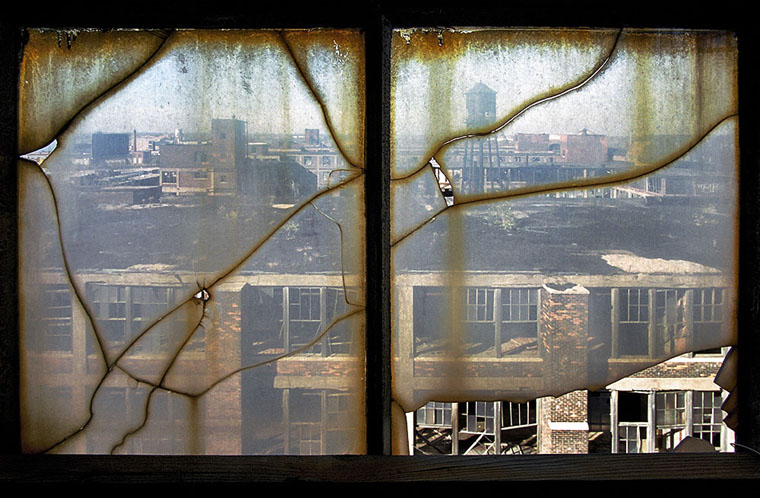
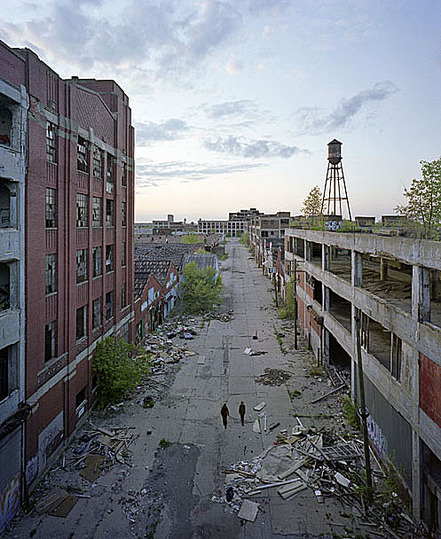

![Detroit etc: Russ: So, what went wrong? Guest: If we go back to those small-scale entrepreneurs of 120 years ago--it's not just Henry Ford; it's the Dodge brothers, the Fisher brothers, David Dunbar Buick, Billy Durant nearby Flint--all of these men were trying to figure out how to solve this technological problem, making the automobile cost effective, produce cheap, solid cars for ordinary people to run in the world. They managed to do that, Ford above all, by taking advantage of each other's ideas, each other supplies, financing that was collaboratively arranged. And together they were able to achieve this remarkable technological feat. The problem was the big idea was a vast, vertically integrated factory. And that's a great recipe for short run productivity, but a really bad recipe for long run reinvention. And a bad recipe for urban areas more generally, because once you've got a River Rouge plant, once you've got this mass vertically integrated factory, it doesn't need the city; it doesn't give to the city. It's very, very productive but you could move it outside the city, as indeed Ford did when he moved his plant from the central city of Detroit to River Rouge. And then of course once you are at this stage of the technology of an industry, you can move those plants to wherever it is that cost minimization dictates you should go. And that's of course exactly what happens. Jobs first suburbanized, then moved to lower cost areas. The work of Tom Holmes at the U. of Minnesota shows how remarkable the difference is in state policies towards unions, labor, how powerful those policies were in explaining industrial growth after 1947. And of course it globalizes. It leaves cities altogether. And that's exactly what happened in automobiles. In some sense--and what was left was relatively little, because it's a sort of inversion[?] of the natural resource curse, because it was precisely because Detroit had these incredibly productive machines that they squeezed out all other sources of invention--rather than having lots of small entrepreneurs you had middle managers for General Motors (GM) and Ford. And those guys were not going to be particularly adept at figuring out some new industry and new activity when the automobile production moved elsewhere or declined. And that's at least how I think about this--that successful cities today are marked by small firms, smart people, and connections to the outside world. And that was what Detroit was about in 1890 but it's not what Detroit was about in 1970. And I think that sowed the seeds of decline.](files/table/U_40_896631897044_011.jpg)
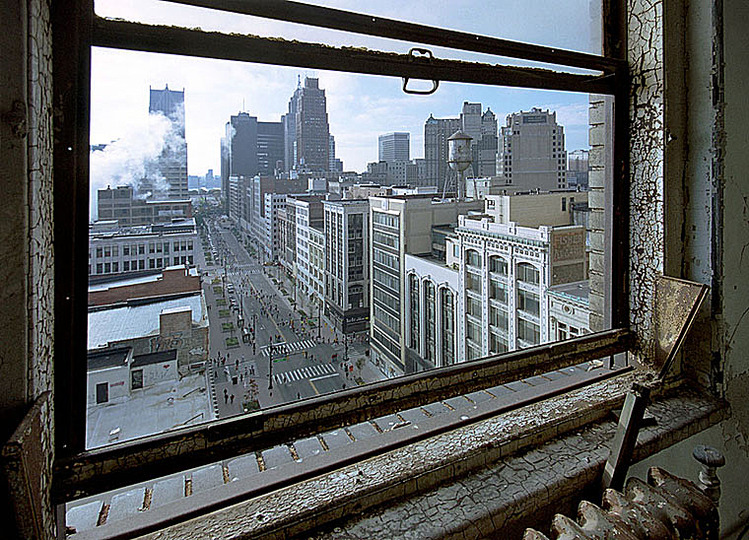



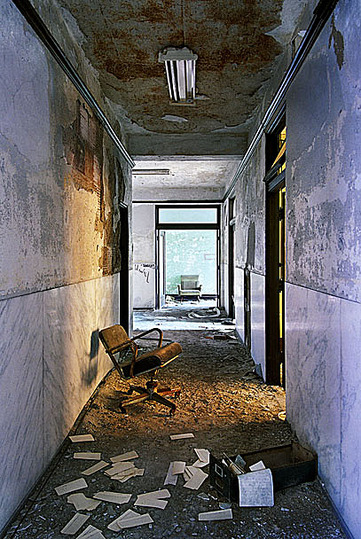

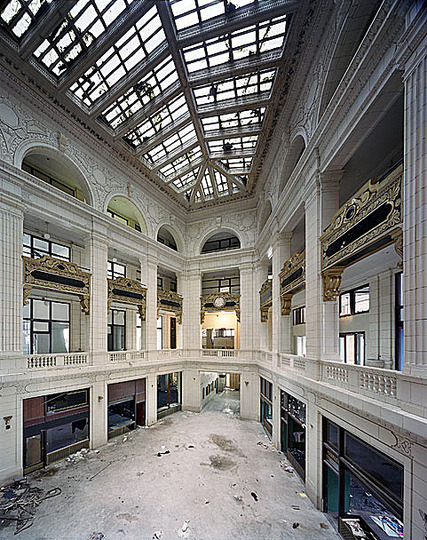

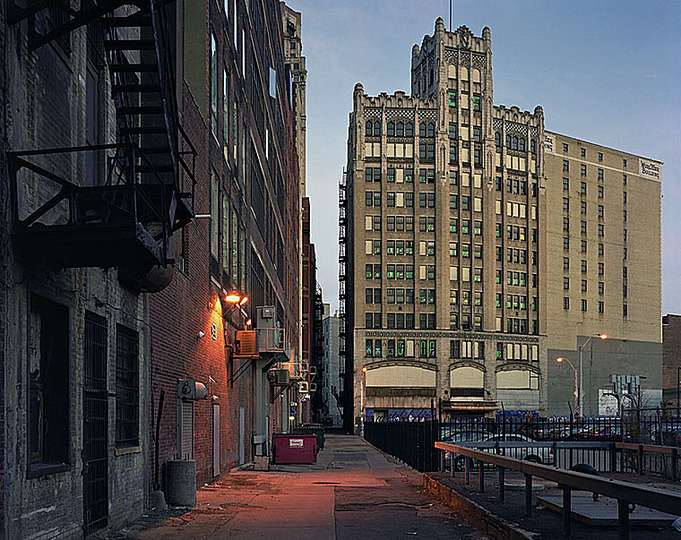
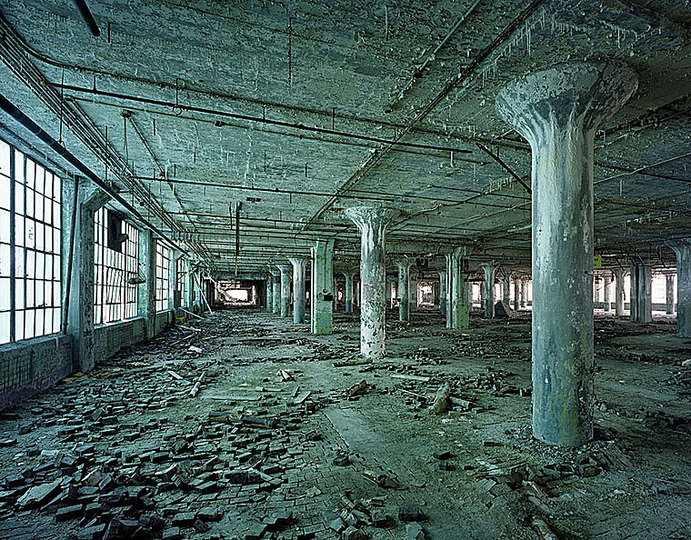
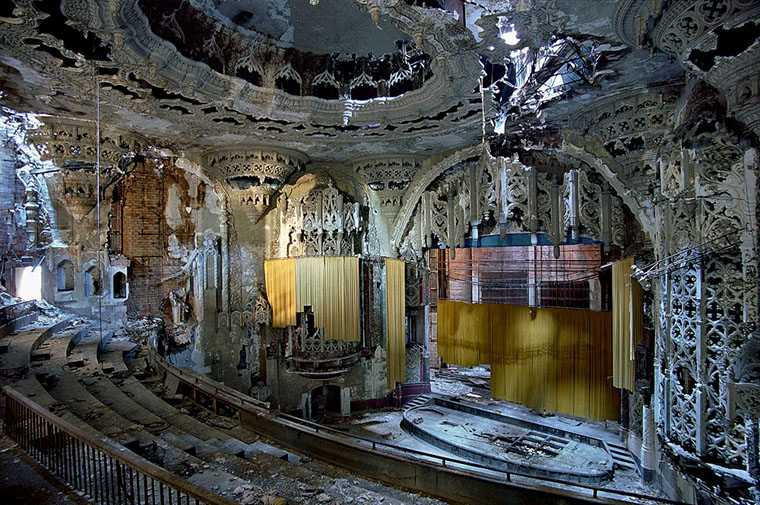
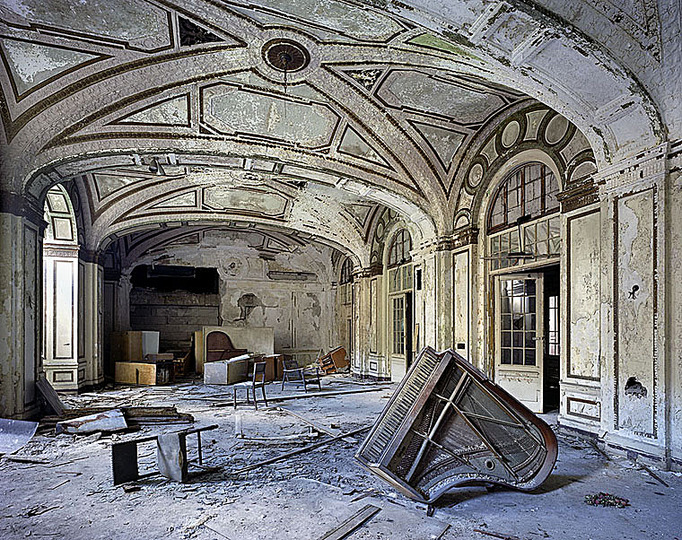
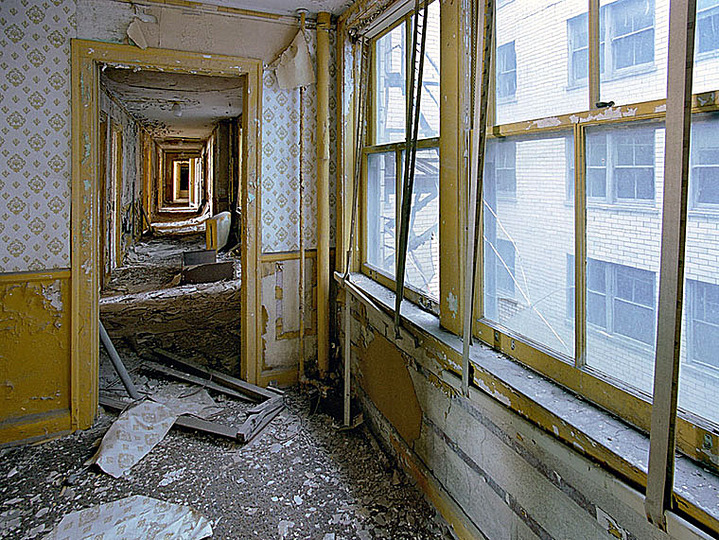
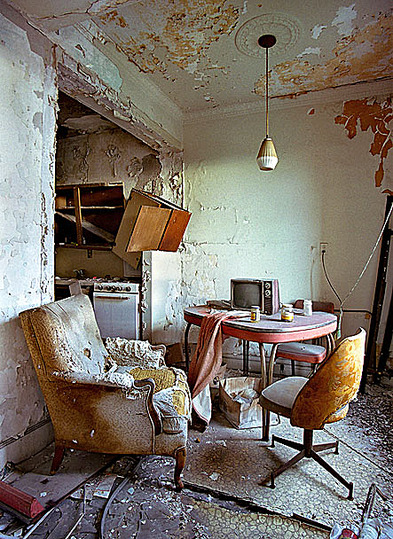
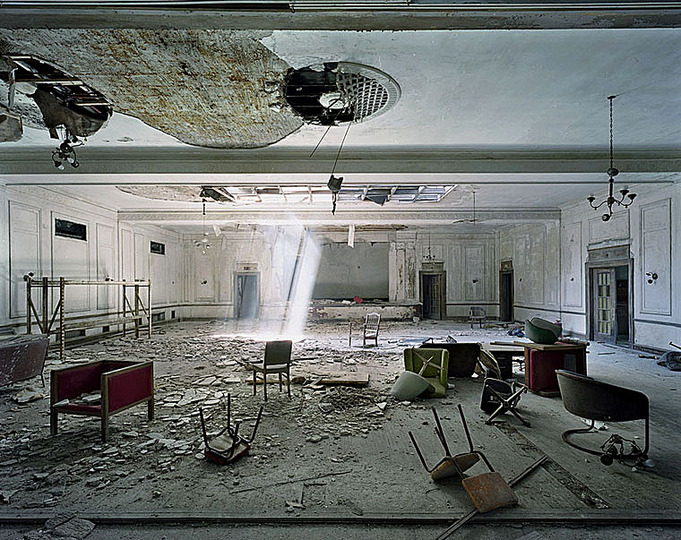

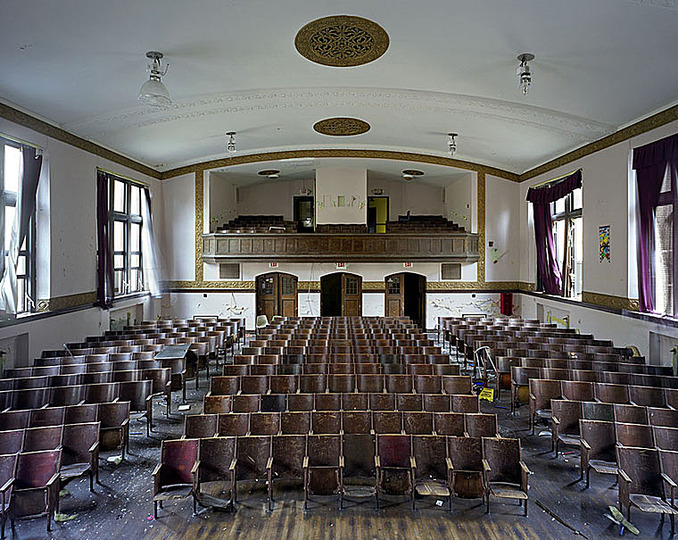

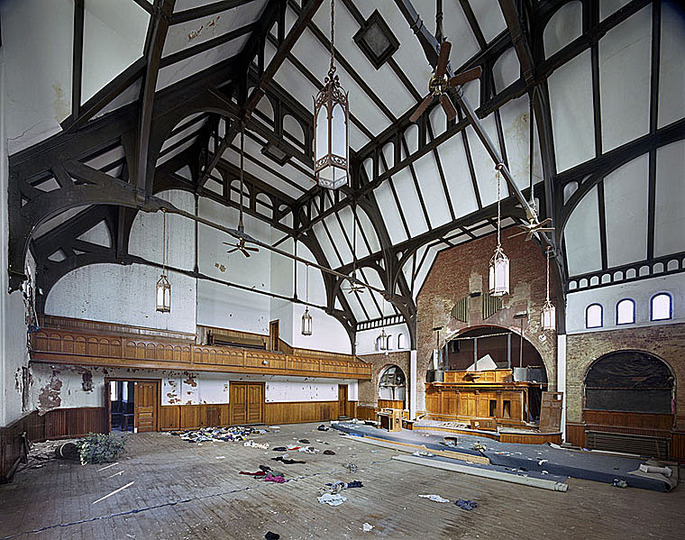
![Detroit etc: Russ: Do you think it's important that those kids at that charter school or at any other ones, whatever good schools there are in Detroit, that they stay in Detroit? Do we really care? We see Detroit has declined. One way to look at it is to say: Well, people vote with their feet; it's a terrible tragedy for the people who are still stuck there because there's not much opportunity. But the most talented ones will leave. They'll go improve other cities. Do we care about Detroit per se? Guest: It's not that we don't care about it. But our primary focus is on people in Detroit, whether or not they choose to live in Detroit or elsewhere. So, the important thing is that those kids are well-educated and find a brighter future wherever they find a brighter future. So, it's not particularly, I mean I'm not disturbed by a kid who moves from Detroit to Houston to find a great life there; and I think that's absolutely right. So, the spirit of your suggestion is quite reasonable to me. I think there are a couple of minor caveats that I'd like to put out there. One of which is: The way that we've structured local government is that we have mayors who are responsible for places[?]. So, I do think it is David Bing's [Detroit Mayor] job to make his city as functional and successful as it can be. Although part of being functional and successful is just educating his kids, not minding if they move elsewhere. In some sense, an analogy I like to make between cities and companies on this, and local and national policy. So, it certainly shouldn't be the business of the national government whether or not one company thrives or fails. We want good national policies, and then there are winners and losers. But it's the job of the Chief Executive Officer (CEO) of that company, to make sure that it thrives. I see that the relationship between cities and national policies being somewhat similar. If the federal government should be picking winners and losers in particular places, it shouldn't be trying to prop up declining cities or populations in particular areas. But when you are looking at David Bing's perspective, he needs to have a bit of a place-related perspective that focuses on his particular location, making it as healthy as it can be. Russ: And he's the Mayor of Detroit. Guest: He is the Mayor of Detroit. Russ: Former National Basketball Association (NBA) player, I remember his jumpshot well.](files/table/U_40_422878028209_143.jpg)
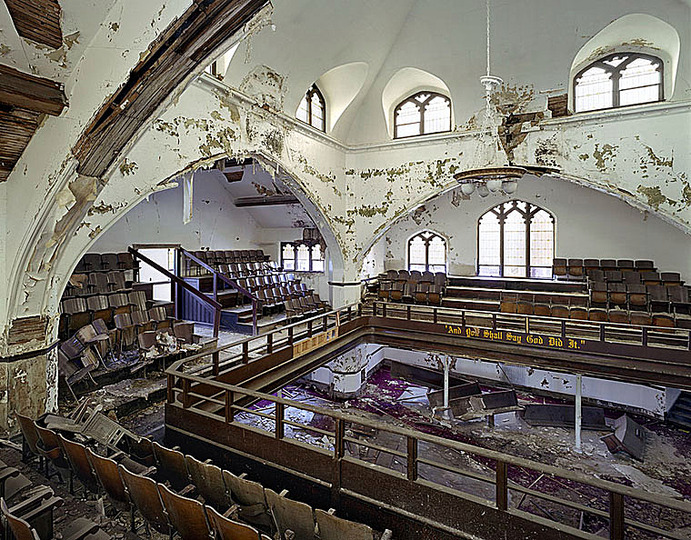
![Detroit etc: Russ: So, if you were mayor of Detroit yourself--King of Detroit, I'd like think of, or maybe you have David Bing's ear, which maybe you do--what would you do? Give me a short term plan and a long term plan. Guest: As you know, Detroit is currently being more controlled by the data pointed financial officers who have power relative to Bing himself. But it's not really rocket science. If you think of it as an overall plan, I would have essentially a transition close to a complete charter school provision in terms of the education side. So I would move almost completely out of the public school education business, if I were Detroit. In terms of policing, I would be doing more in terms of borrowing from those cities that have had very successful turnarounds in the quality of their policing. So, I know for example there's a project going on where they are borrowing from New York's successes. Boston has also had a reasonably successful policing--so many cities have. I'm not a police tactics expert, but I'd certainly be borrowing from that. I would be trying to privatize as much of the dysfunctional space in the city as I possibly can. The city, its physical footprint is so large, that creates just a very, very hard cost equation. They have not been as aggressive at using eminent domain to level neighborhoods as say for example Flint has. I'm myself quite wary of the use of eminent domain; every part of me that fears the excessive use of the power of the state, fears eminent domain, although I'm willing to believe that there are occasions where it is necessary. In this case I think there's a better approach. Which the mayor is basically following, which is you are going to restrict the areas in which public services are available all for [?] aid to people who are outside those areas, and then either charge them for the incremental cost of city services if they are outside of it or basically not provide certain city services outside of these core areas.](files/table/U_40_710750773632_271.jpg)
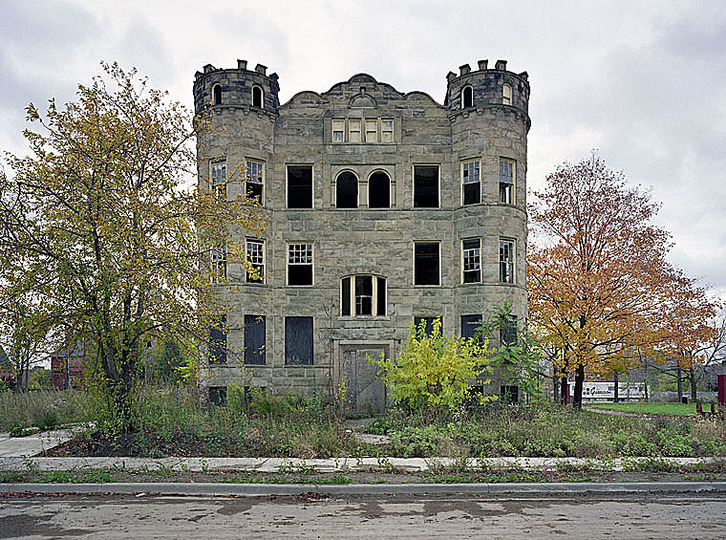
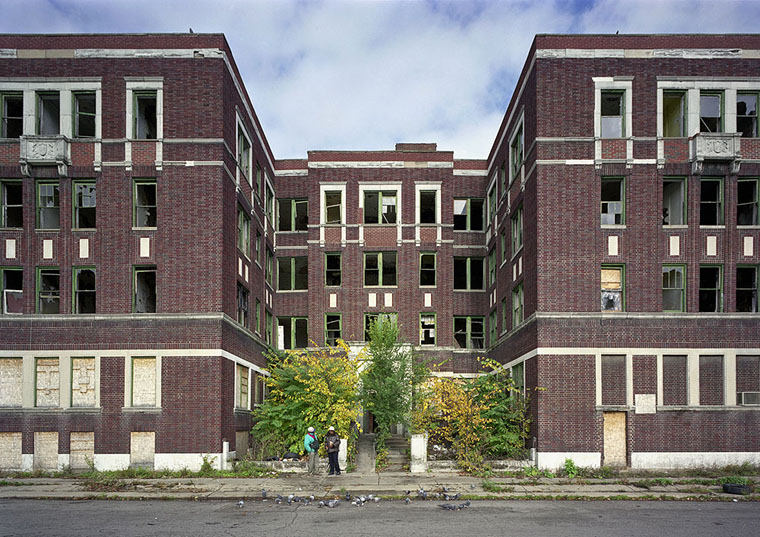
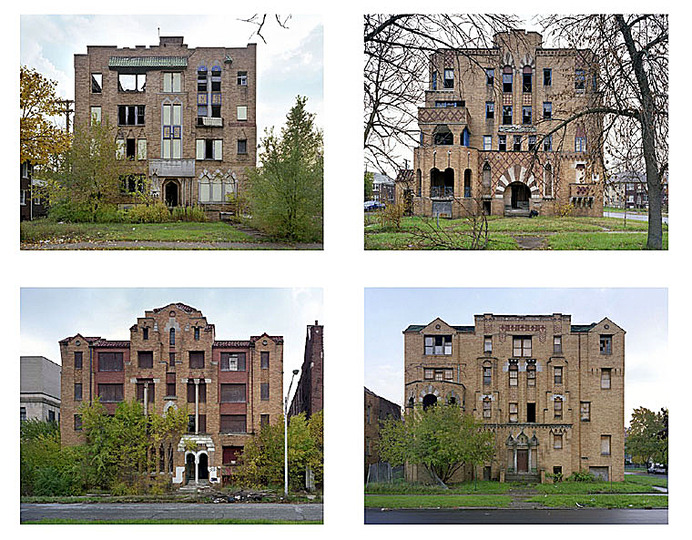
![Detroit etc: Russ: Do you have a feel for what proportion of Detroit's employment right now is public versus private? Guest: Well, we have county business patterns data on this. That would be Wayne County rather than Detroit proper. So, Wayne County includes Detroit. Between 1998 and 2010 the number of paid employees in Wayne County declined from 755,000 to 570,000. So that's really a massive difference. And the number of manufacturing employees, the traditional heart of the Detroit economy has literally declined by 50%, from about 120,000 to about 60,000. One of the areas that's still very, very robust, and this gives [?] public private, the issue is that health care and social assistance, an industry that is traditionally driven by public sector spending, that is now 100,000 employees out of Wayne County's total 568,000. Russ: That's large. You alluded a minute ago to this idea of making people pay for the services--you said it in a couple of different places and ways--that they use. What's your thought on urban sprawl generally? Do you think it's a problem? Have we subsidized the suburbs overly in a way that's been destructive? Guest: We probably should be doing more to make sure people pay for the social cost of their actions. I think it was always inevitable that America would rebuild itself around the automobile. I don't think the right answer is we should expect no sprawl. Or tiny amounts of sprawl. We should expect a lot of sprawl. I think we can have somewhat better policies. We come back again to think about highways. It's I think entirely appropriate that people should be paying for the costs of driving, including of course myself, both in terms of either using gas taxes or better yet using tolls to do that. And obviously when you have new development it should pay for the social cost of hooking up public services that are involved. I don't think that that would massively reduce the amount of building on the urban edge. I think the lure of the car and car-based living is very, very strong.](files/table/U_40_449729783776_182.jpg)

